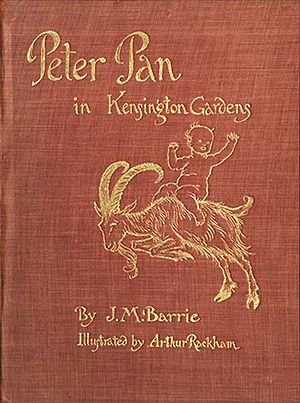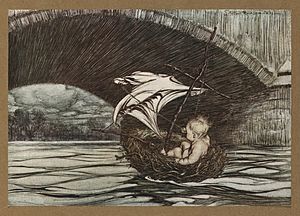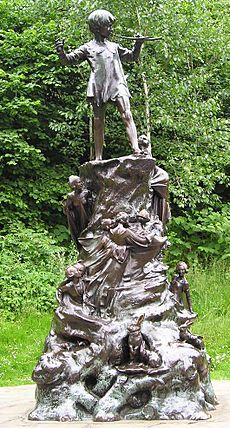Peter Pan in Kensington Gardens facts for kids

First edition
|
|
| Author | J. M. Barrie |
|---|---|
| Illustrator | Arthur Rackham |
| Cover artist | Arthur Rackham |
| Country | United Kingdom |
| Language | English |
| Genre | fantasy, children's literature |
| Publisher | Hodder & Stoughton |
|
Publication date
|
1906 |
| Preceded by | The Little White Bird |
| Followed by | Peter and Wendy or Peter Pan, or the Boy Who Wouldn't Grow Up |
Peter Pan in Kensington Gardens is a fantasy novel by J. M. Barrie. It was published in 1906 and features the famous character Peter Pan. The book includes beautiful pictures by Arthur Rackham. Most of this story first appeared in Barrie's earlier novel, The Little White Bird, which came out in 1902.
Contents
Peter Pan's Amazing Story

The story begins with Peter as a tiny baby, just seven days old. Like all babies in this story, he used to be part bird. Peter believed he could fly perfectly. One day, he heard his parents talking about his future as an adult. This made him fly out of his London home window and back to Kensington Gardens.
When Peter arrived in the Gardens, he met a crow named Solomon Caw. Solomon told Peter a surprising truth. Peter was not a bird anymore. He was a mix of human and bird, a "Betwixt-and-Between." This news made Peter realize he could no longer fly. He was stuck in Kensington Gardens.
At first, Peter could only walk around. But then he had an idea! He asked for a special nest to be built. This nest was like a small boat. He used it to travel across the Serpentine, a big lake in the Gardens. This way, he could explore more of the park.
Peter and the Fairies
When Peter first arrived, the fairies were scared of him. But he soon became their friend. He entertained them with his human ways. He also played his panpipes for their dances.
Eventually, Queen Mab, the fairy queen, offered Peter a wish. He wished to go back home to his mother. The fairies helped him fly. He found his mother sleeping in his old room.
Peter felt bad for leaving his mother. He thought she missed him a lot. He thought about staying with her. But first, he wanted to say goodbye to the Gardens. He stayed too long. When he used his second wish to go home for good, he was heartbroken. His mother had a new baby boy. She now had someone else to love. Sad and alone, Peter went back to Kensington Gardens.
Peter's Friends and Games
Later, Peter met a little girl named Maimie Mannering. She was lost in the Gardens. Peter and Maimie quickly became good friends. Peter even asked her to marry him! Maimie wanted to stay with him. But she knew her mother would be worried. So, she left Peter to go home.
Maimie never forgot Peter. When she grew older, she sent him gifts and letters. She even gave him an imaginary goat. Peter would ride this goat every night. Maimie was an early version of Wendy Darling. Wendy appears in Barrie's later Peter and Wendy story.
Peter often misunderstood simple things. He didn't know what a baby carriage (pram) was. He thought it was an animal. He also loved a boy's lost kite very much. Maimie was the one who told him he was playing all his games wrong. When Peter wasn't playing, he made graves for lost children. He buried them with small headstones in the Gardens.
Other Peter Pan Stories
Most of Peter Pan in Kensington Gardens was first part of Barrie's 1902 novel, The Little White Bird. That book was written for adults. But Peter Pan in Kensington Gardens was made especially for children. Many people think it's also a book for art collectors. This is because of the beautiful pictures by Arthur Rackham in the 1906 edition.
In 1904, Barrie wrote a play called Peter Pan, or the Boy Who Would Not Grow Up. It was performed in December of that year. This play is not a direct follow-up to the novel. It's a different story. But it uses the same ideas and the Peter Pan character. In the play and later novels, Peter Pan is a bit older than he is in Kensington Gardens.
The play became the basis for Barrie's 1911 novel, Peter and Wendy. This novel was later called Peter Pan and Wendy and then just Peter Pan. The play script itself was published in 1928.
Where the Story Takes Place
The story happens in Kensington Gardens. This is one of the Royal Parks in London. Much of the story happens after "Lock-Out Time." This is when the park gates close for the day. After this time, the fairies and other magical creatures can move freely. During the day, they have to hide from people. Fairies in Kensington Gardens were first written about in a poem by Thomas Tickell in 1722.
Pictures and Book Versions
Arthur Rackham was asked to draw pictures for the book. He was chosen because of his successful work on another book, Rip Van Winkle, in 1905. Rackham had about 18 months to finish all the drawings.
The first edition of Peter Pan in Kensington Gardens came out in two main types. There was a regular edition for everyone. There was also a special, limited edition of 500 copies signed by the artist. Both versions had 50 color pictures and 3 black and white drawings. These pictures were shown in an art gallery in November 1906.
In 1912, a new version of the book was released. It had some changes and 9 more black and white drawings. In this version, the pictures were placed right within the story text. In the 1906 edition, all the pictures were at the end of the book.
Stage Shows and More
In 2019, a theater company called Betwixt-and-Between turned Peter Pan in Kensington Gardens into a stage play. They performed it at the Edinburgh Fringe and at Moat Brae. Charlotte Ellen adapted and directed the play.


